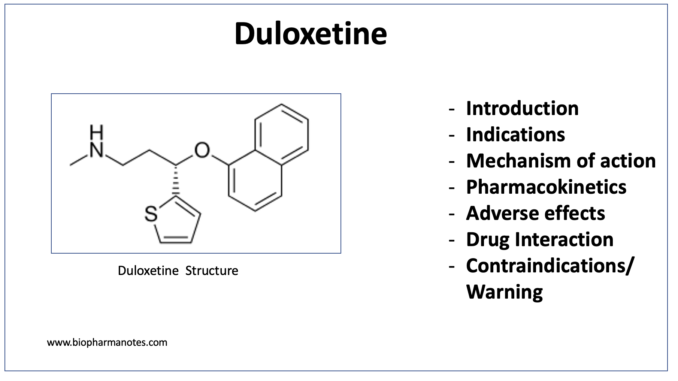
- Duloxetine is dual serotonin and nor-adrenaline reuptake inhibitor (SNRI) and is a second-generation anti- depressant. It was originally discovered in 1993. However, duloxetine received its FDA approval for treatment of Major Depressive Disorder (MDD) only in 2004.
Indications of duloxetine
- For treating Major Depressive Disorder and generalized anxiety disorder.
- In fibromyalgia.
- Chronic musculoskeletal pain.
- Chronic lower back pain in adults.
- Diabetic Neuropathy.
- Some of its off label uses include stress urinary incontinence and chemotherapy induced peripheral neuropathy.
Mechanism of action of duloxetine

It inhibits neuronal reuptake of serotonin and nor-adrenaline which results in availability of more serotonin and nor-adrenaline to transmit message between neurons and help to relieve symptoms of depression. Increase in serotonin and nor-epinephrine concentration activate different serotonin and adrenergic receptors and increases descending inhibition of pain. Hence, it stops pain signals reaching the brain.
It also inhibits reuptake of dopamine and has no significant activity on cholinergic, muscarinic, alpha-2 adrenergic and histaminergic receptors.
Pharmacokinetics of duloxetine
- Duloxetine is lipophilic and is well absorbed after oral administration. It can be taken with or without food. The dose may vary depending on its use. For managing fibromyalgia, 30 mg once daily is administered which may be increased to 60 mg once daily. The initial dose for generalized anxiety disorder is 60 mg. for some patients, it may be 30 mg once daily for one week and then increased to 60 mg once daily.
- Around 90% of the drug bind to plasma proteins, albumin, and alpha-1 acid glycoprotein. It can cross blood brain barrier. Metabolism takes place primarily in liver by CYP1A2 and CYP2D6 enzymes.
- Its plasma half-life is around 12 hours.
Adverse effects
- Some of its common adverse effects include headache, fatigue, drowsiness, weakness, insomnia, weight loss, constipation, erectile dysfunction etc. It can cause serious side effects like hyponatremia, syncope, hepatotoxicity, suicidal effects, serotonin syndrome and mania.
- FDA issued a black box warning about duloxetine in 2014 about increased risk of suicidal thoughts and behavior in children.
Drug Interactions
- It may increase concentration of drugs like antipsychotics, tricyclic antidepressants, and anti-arrhythmic drugs by inhibiting CYP2D6 enzymes.
- Concurrent administration with drugs like other SNRIs and SSRIs may increase risk of serotonin syndrome. Symptoms of serotonin syndrome include confusion, agitation, dilated pupil, rigid muscle etc. Concurrent administration with aspirin may increase risk of bleeding.
- Heavy alcohol drinking can increase risk of livers stress and damage caused by duloxetine. Grapefruit or grapefruit juice may affect duloxetine’s metabolism and increase its concentration in body leading to increase in risk of side effects.
Contraindications
- Contraindicated in patients with hypersensitivity to duloxetine.
- It is contraindicated in patients who are on MAO inhibitor therapy.
- Contraindicated in patients with uncontrolled angle- closure glaucoma.
- Avoided in patients with hepatic dysfunction or severe renal dysfunction.
- It is pregnancy category C drug which means its effect in pregnant women and fetus had not been studied. So, it is used in pregnancy only if potential benefits outweigh its risks. It is excreted in breast milk.
- Used with caution in geriatric population.
References
- https://go.drugbank.com/drugs/DB00476
- https://www.statpearls.com/ArticleLibrary/viewarticle/20751
- https://journals.sagepub.com/doi/full/10.4137/CMT.S1988
- https://www.drugwatch.com/cymbalta/
- Bellingham GA et al. Duloxetine: A Review of its Pharmacology and Use in Chronic Pain Management. Regional Anesthesia and Pain Medicine. 35(3).
- Partin AW et al. Pharmacologic Management of Lower Urinary Tract Storage and Emptying Failure. 2021.
- Gupta S et al. Duloxetine: review of its pharmacology, and therapeutic use in depression and other psychiatric disorders. Ann Clin Psychiatry. Apr-Jun 2007;19(2):125-32.
- Lippincott’s Illustrated Reviews, Pharmacology. 6th edition.